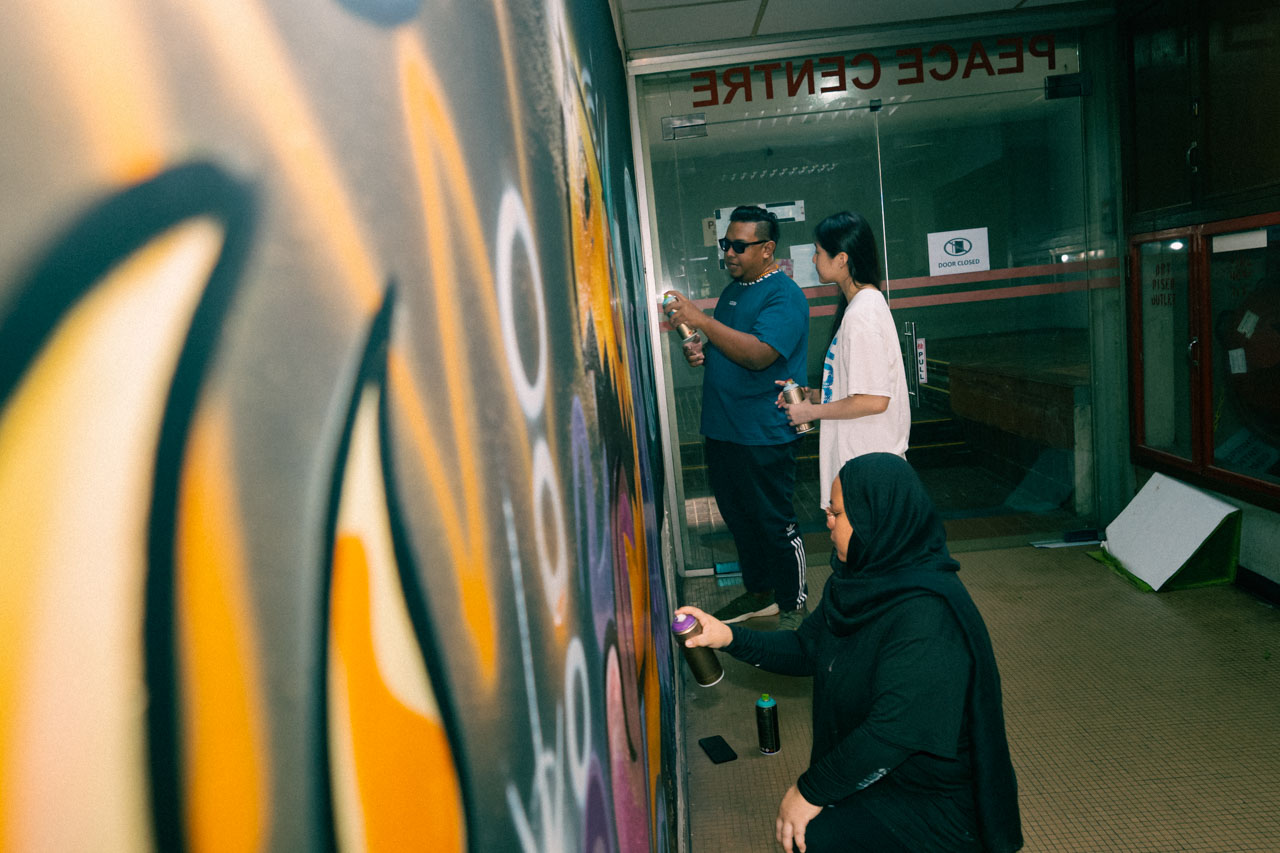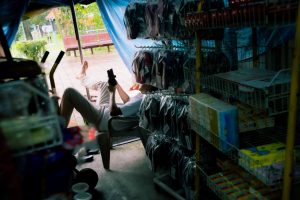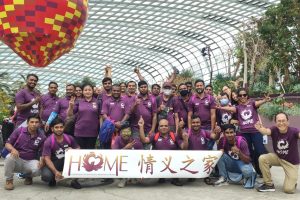All images by Stephanie Lee for RICE Media unless stated otherwise.
“Ah, Peace Centre. We used to go there to print textbooks. Back when copyright not so strict,” my Grab driver tells me with an air of nostalgia. Confusion comes next. What business did a “young girl” like me (his words, not mine) have going to an abandoned mall?
His confusion remains even after I explain that I’m heading there to visit PlayPan, the community and social engagement movement that’s now inhabiting the building.
ADVERTISEMENT
It’s understandable. The concept is a little hard to wrap your head around. Peace Centre changed hands for $650 million in a 2021 en bloc sale, and was slated for demolition in 2023. Why would this prime land on Sophia Road be left to the devices of a bunch of creatives, artists, small businesses, and social enterprises for months before the building gets torn down?
Yvonne Siow, who founded PlayPan together with good friend Gary Hong, tells me that the idea was to give back to society and create a space where people could do good.
They pitched the idea to the building’s new owners and were able to get the support of Michael Ng, the regional executive director for CEL Development (the company bought the mall in a joint deal with Sing-Haiyi Crystal and Ultra Infinity).
It’s ironic. Now that the mall has an expiry date (early 2024), it’s probably getting more attention than it’s gotten in the last decade. It’s also the coolest it’s ever been.
Peace Centre in Its Heyday
Before we had cookie-cutter malls, we had our pioneer malls: Peace Centre, Golden Mile Centre, and People’s Park Complex. These were among the first shopping malls to open after Singapore’s post-colonial construction boom.
ADVERTISEMENT
Peace Centre wasn’t always the dark, dingy mall you visited when you needed to print something for cheap.
The mall opened for business in December, 1974. The entire development, including the residential Peace Mansion, was completed around 1977.
With its 33 storeys, it was said to “dwarf the neighbouring Cathay Building”, one of Singapore’s first high-rise buildings. It also boasted the country’s newest and largest bowling centre at the time, Starbowl.
By 1993, however, the shopping mall had lost its shine. The pioneer shopping mall couldn’t keep up with competition from newer malls such as Raffles City and Marina Square.
Its undoing, according to a 1993 Business Times article, was that it was a strata-titled shopping centre, with no single owner having majority ownership. This meant that the tenant mix was left up to market forces. Shopping centres with a single tenant enjoying majority ownership, however, can control their tenant mix and shift their retail planning strategies based on consumer demand.
It took on a seedy reputation when KTV lounges sprouted up in the mid-2000s, and residents began to complain that Peace Centre wasn’t peaceful any longer.
Like Business Times predicted, Peace Centre slowly faded into obscurity, known mostly for printing shops and private education centres.
Today, however, it’s been taken over by an eclectic mix of tenants. Social enterprise My NoNNa’s sells locally grown produce out of its ground floor stall. Thrift and vintage stores pepper the building. Street art workshops using the mall’s walls as a canvas take place every weekend.
Most of the tenants pay a subsidised rent. Non-governmental organisations, schools, and ground-up initiatives get it for free, while “a handful of partners” contribute to a fund to keep this social movement going, says Yvonne.
Doing good is the common thread tying all the tenants together, Yvonne explains. Most of them are artists or social enterprises. All of them have some sort of cause.
She tells me as we walk around the mall: “These changemakers bring good vibes and good ideas into the space. And that’s why I’m willing to leave them to be free with what they want to do.”
This free rein given to youths and the art community is part of the reason why Peace Centre has, in its last days, suddenly become the cool new hangout spot.
I can’t help comparing the space to ones like *Scape, which feels sanitised, unimaginative, and underused.
It’s no fault of the developers. It’s just that an overpolished mall with clearly designated spaces for use (graffiti allowed on this wall only; dance sessions in that corner specifically) doesn’t have the same appeal as an empty canvas.
An Unlikely Hub for Artists
The most obvious change to the space is the mural art. Artist’s tags dot the wooden bannisters. Graffiti spans abandoned shopfronts. Old floor directories—now no longer relevant—are partially covered by spray paint.
There are several artists to thank for the mall’s facelift. Among them are Fanny Ozda, Jon Chan (also known as the blind swordsman), and DPLMT (pronounced “diplomat”), a multidisciplinary art collective. DPLMT’s spray-painted murals are peppered throughout Peace Centre. And their most recognisable piece in the place is probably the Enter The PlayPan piece splashed over the entrance.
EBAO (real name: Mohamed Iqbal) one of the founding members of DPLMT, tells me that the place is like a free canvas, different from other designated spaces for art.
“Of course, being street artists, it’s hard to find mural walls in Singapore without getting on the wrong side of the authorities,” he tells me. We’re speaking on the sidelines of DPLMT’s spray-painting workshop.
He’s wearing sunglasses indoors. Fellow DPLMT co-founder Raihana, also known as Araikreva, jokes that it’s his thing.
I comment that it’s only been weeks since my last visit, and there are already more murals all around the space.
EBAO nods and offers: “It’s a canvas of sorts. It’s turned into something like an accidental beauty.”
There have been other abandoned areas opened up to street artists before. He lists 369 Tanjong Katong, and the Eminent Plaza takeover in 2014. But having a space like this inhabited by social enterprises and other creatives is new.
He and his fellow tenants often stay after closing hours to talk, he says. With such an open sharing of ideas, collaborations have been born, like the one with Lost SG, an escape room chain. Together, they’re creating Singapore’s first glow-in-the-dark escape room.
“This is like a proof of concept. Something like this—an abandoned space—can be turned into something great if we find great people,” EBAO says. “I know sometimes some artists feel like there are no opportunities, but it’s all about exploring, and putting themselves out there. Just wait for the right wave to ride.”
Sure, there are very real costs involved with setting up shop. But he says the rental is “not very expensive” and the administrative side of setting up shop at PlayPan is just “nitty gritty things”.
“The bottom of the iceberg is the inspiration, the camaraderie, and working together with other people. It’s a beautiful thing.”
Kampung Vibes
Entering Peace Centre now feels like stumbling upon one of those HDB cosy corners. The kind that starts with one neighbour leaving out a bench for communal use. Others contribute in their own ways. A potted plant here, a swing set there. Then it becomes the spot to chill and shoot the breeze with neighbours. It’s makeshift, it’s communal, it’s organic.
It’s just a few months in, and everyone seems close-knit. As my photographer Steph and I traverse the building to photograph our interviewees, we get sidetracked by all the people they introduce us to. EBAO shows us Fanny’s studio. She’s in the middle of painting a sprawling wall mural. We also get to meet the Lost SG guys, who are collaborating with DPLMT on the escape room.
Yvonne tells me that it truly is kampung vibes here. The tenants bounce ideas off each other and contribute out of their own volition. Much of the furniture is donated. For example, a few of them suggested creating a mediation space out of the empty room we’re sitting in now. An artist scuttles in, toting a piece of tarp and painting materials. She double-checks with Yvonne if she can paint the wall in front of us, and Yvonne cooly tells her it’s hers, simple as that.
PlayPan’s even given rise to new social enterprises. Chan Yee Yin, 54, runs Blueprint Principles, a vintage shop on the third floor of the mall which donates its proceeds to charity and aims to help at-risk kids and low-income families. Blueprint Principles didn’t even exist before PlayPan, the retiree says. But she and her husband had attended an event there and found the concept exciting.
“This is weird, but yet wonderful. I mean, we’ve never heard such a thing like that.”
Seeing so many social enterprises in one space inspired her to start her own with partner Pamela Chong, 59. It was an opportunity to contribute more to causes close to their heart like IJ Homes & Children’s Centres and Beyond Social Services.
A big part of the reason why her shop was able to come together in a matter of weeks was because so many people pitched in, she says. The artificial turf in her shop came from a social enterprise downstairs. The clothes were donations from friends, and some of her furniture was loaned from an interior designer friend.
The generosity goes both ways. Yee Yin laughs as she tells me, “We’re probably the only ones around here that have a ladder. So everybody knows. If they need a ladder, they’ll come.”
It’s not just artists and secondhand shops here. Yvonne introduces me to Chris Milliken, 51, the co-founder of Pengwine. Chris is unperturbed when I admit I know nothing about wine. In fact, he’s promptly offers me a wine and a book he wrote titled ‘White or Red, It’s All In Your Head!’. I make a mental note to read up simply because he’s so enthusiastic.
Pengwine, a wine importer, has a bar space on the third floor of the mall where they showcase their wines. It’s become something of a hangout spot for tenants like Yee Yin. Pengwine had come in around Halloween to host a party, and stayed when Chris understood Yvonne and Gary’s vision.
He sees the space as an accelerator of sorts. He’s trying to do all sorts of newfangled things by marrying blockchain and wine (he tries to explain, and I only sort of get it).
He tells me that it’s “bittersweet” that everything will come to an end when Peace Centre’s demolishment goes ahead early next year. But for now, he’s making the most of the PlayPan experience.
“It would take me years to meet as many like-minded people as I’ve met in the last three weeks.”
Fluke? Or the Future of Abandoned Spaces?
Like HDB cosy corners, though, these community-driven spaces are highly dependent on compromise and collaboration. People are happy to share resources and ideas here. It does help that tenants are “curated”, according to Yvonne. And as EBAO tells me, it’s “a good crowd” here.
Organisational and administrative challenges aside—Gary and Yvonne both have day jobs outside of this project—I get the sense that most of the building’s inhabitants really want this to work. As we speak, there’s an awareness that PlayPan is a temporary thing, but there’s also the hope that this proof of concept with give rise to other similar spaces in the future.
As Peace Centre’s eventual closure date looms ahead, I think it’s the feeling of genuine respect and community among the contributors of PlayPan that I’ll miss. They’re the ones who’ve poured their inspiration into the space and transformed it.
The once-dead mall has become such a vibrant space precisely because there aren’t strings attached to the space, and the inhabitants are pretty much given free rein. In Singapore, at least, that something we rarely see, even with places that are about to be demolished.
It’s easy to hail this as a model for other decommissioned spaces. PlayPan’s success has even caught the attention of Central Singapore District Mayor Denise Phua, who called it the “best kept secret” at Peace Centre. But who knows? A top-down attempt at manufacturing a Peace Centre 2.0 might just end up creating something more like a *Scape.
Yvonne and Gary have somehow managed to work their magic and get Peace Centre’s new owners on board, as well as secure enough tenants to keep the place running till next January. Despite the subsidised rent for some tenants, the model is self-sustaining, she says. But who’s to say the stars will align the next time a building is slated for demolition?
At the risk of sounding like a wet blanket, for all the good its tenants have done, and all the connections forged, PlayPan isn’t making money at the end of the day. Keeping the lights is not cheap (Yvonne declines to share exactly how much it costs). Actually keeping it running smoothly is obviously not an easy undertaking either.
But what they’ve proven is that giving people autonomy and full rein of a space works. At least, it makes for a joint that people actually find cool. In an age where malls are dying left and right, and cookie-cutter malls reign supreme, maybe this is what we need.






